- Disconnect the battery negative cable. Refer to
Battery Negative Cable Disconnection and Connection
in Engine Electrical.
- Remove the engine cover. Refer to
Engine Cover Replacement
in Interior Trim.
- Remove the air cleaner assembly. Refer to
Air Cleaner Assembly Replacement
in Engine Controls-4.3L.
- Remove the air cleaner outlet duct from the throttle body. Refer to
Air Cleaner Outlet Resonator Replacement
in Engine Controls-4.3L.
- Remove the following components:
| • | The transmission cooler lines |
- Disconnect the air conditioning hose at the accumulator and the condenser, if equipped. Refer to
Auxiliary Air Conditioning Compressor and Condenser Hose Replacement
in Heating Ventilation and Air Conditioning.
- Remove the bolts holding the condenser to the radiator.
- Remove the radiator. Refer to
Radiator Replacement
in Engine Cooling.
Caution: In order to avoid possible injury or vehicle damage, always replace
the accelerator control cable with a NEW cable whenever you remove the engine
from the vehicle.
In order to avoid cruise control cable damage, position the cable out
of the way while you remove or install the engine. Do not pry
or lean against the cruise control cable and do not kink the cable. You must
replace a damaged cable.
- Remove the accelerator control cable. Refer to
Accelerator Control Cable Replacement
in Engine Controls-4.3L.
- Remove the cruise control cable, if equipped, from the throttle shaft. Refer to
Cruise Control Cable Replacement
in Cruise Control.
- Remove the cruise control cable from the accelerator control cable bracket.
- Remove the power steering reservoir and drain the fluid. Refer to
Remote Power Steering Fluid Reservoir Replacement
in Power Steering Systems.
- Disconnect the pipes from the hydro boost unit. Refer to
Power Brake Booster Replacement
in Hydraulic Brakes.
- Disconnect the master cylinder from the hydro boost unit. Refer to
Master Cylinder Replacement
in Hydraulic Brakes.
- Tie the master cylinder to the oil fill tube.
- Disconnect the steering shaft from the steering gear. Refer to
Intermediate Steering Shaft Replacement
in Steering Wheel and Column.
- Disconnect the heater hoses from the engine. Refer to
Heater Inlet Hose Replacement
in Heating Ventilation and Air Conditioning.
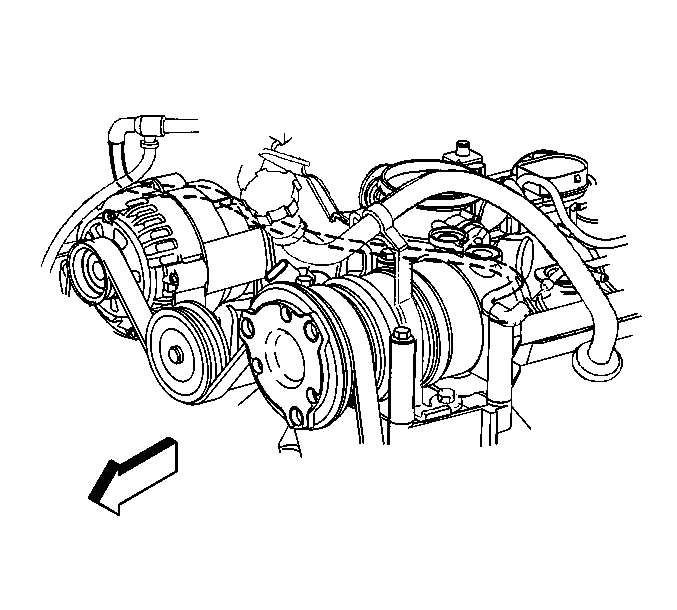
- Disconnect the vacuum hose to the vacuum tank from the intake manifold.
- Disconnect the engine wiring harness from the VCM.
- Disconnect the fuse box and the wiring harness from the bulkhead connector.
- Disconnect the negative battery cable from the battery. Disconnect the battery cable assembly from the fender and the radiator support. Refer to
Battery Negative Cable Replacement
in Engine Electrical.
- Secure the battery cable assembly to the engine.
- Disconnect all related electrical connectors that connect the wiring harness to the body under the hood including the following:
| • | The differential pressure input switch |
- Remove the wiring harness from the retainers and lay the harness on the engine.

- Remove the front section of the running boards, if equipped. Refer to
Assist Step Front Extension Replacement
in Frame and Underbody.
- Install the J 41602
to the pinch weld area on both sides of the vehicle.
- Position the front hoist arms under the J 41602
. Refer to
Lifting and Jacking the Vehicle
in General Information for correct position of the rear hoist arms.
- Make sure the rear of the vehicle is slightly higher than the front.
- Raise the vehicle.
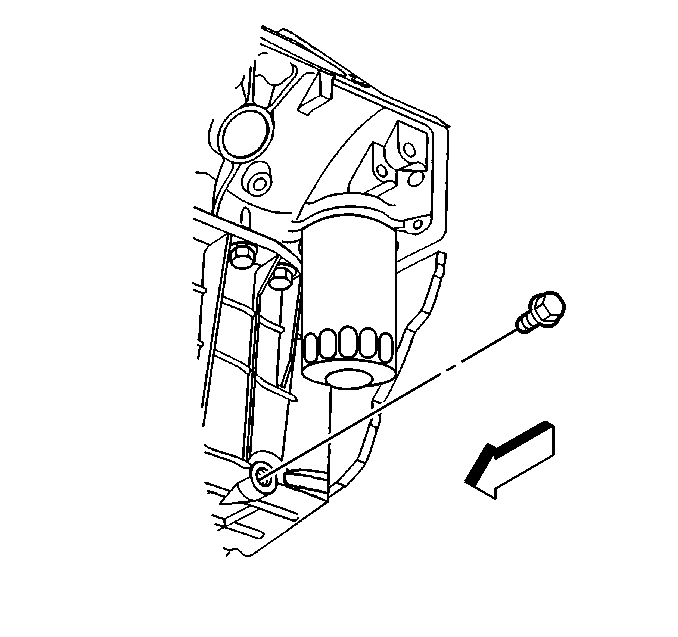
- Remove the oil pan drain plug and drain the engine oil into a suitable container.
- Remove the engine oil cooler pipes from the oil filter adapter. Refer to
Engine Oil Cooler Hose/Pipe Replacement
in Engine Cooling.
- Remove the rear propeller shaft. Refer to
Rear Propeller Shaft Replacement
in Propeller Shaft.
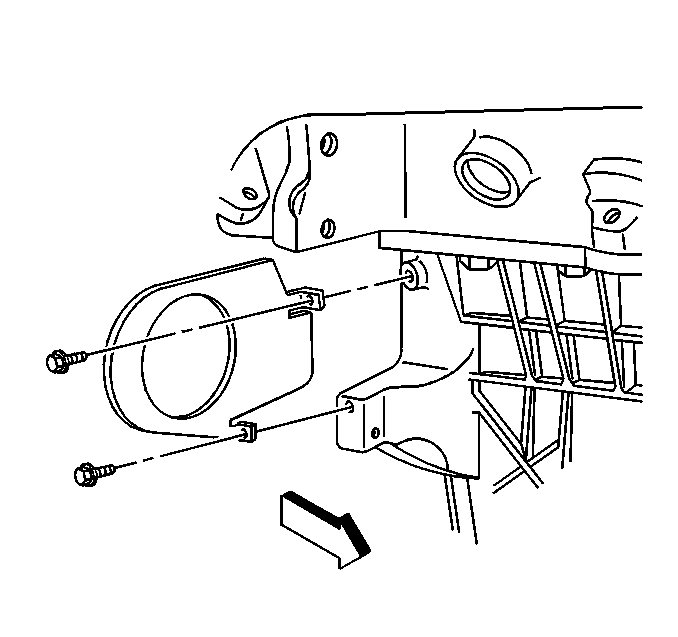
- Remove the starter. Refer to
Starter Motor Replacement
in Engine Electrical.
- Remove the transmission cover.
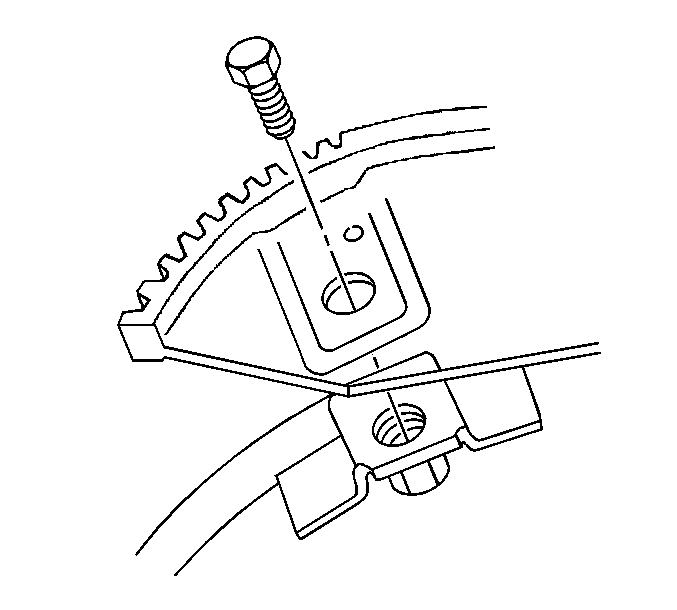
- Remove the torque converter bolts through the starter opening.
- Disconnect the shift cable from the transmission. Refer to
Range Selector Lever Cable Replacement
in Automatic Transmission-4L60-E.
- Remove the heat shield.
- Disconnect the exhaust system at the main flange behind the catalytic converter. Refer to
Catalytic Converter Replacement
in Engine Exhaust.
- Remove the muffler and tail pipe section from the hangers and remove from the vehicle.
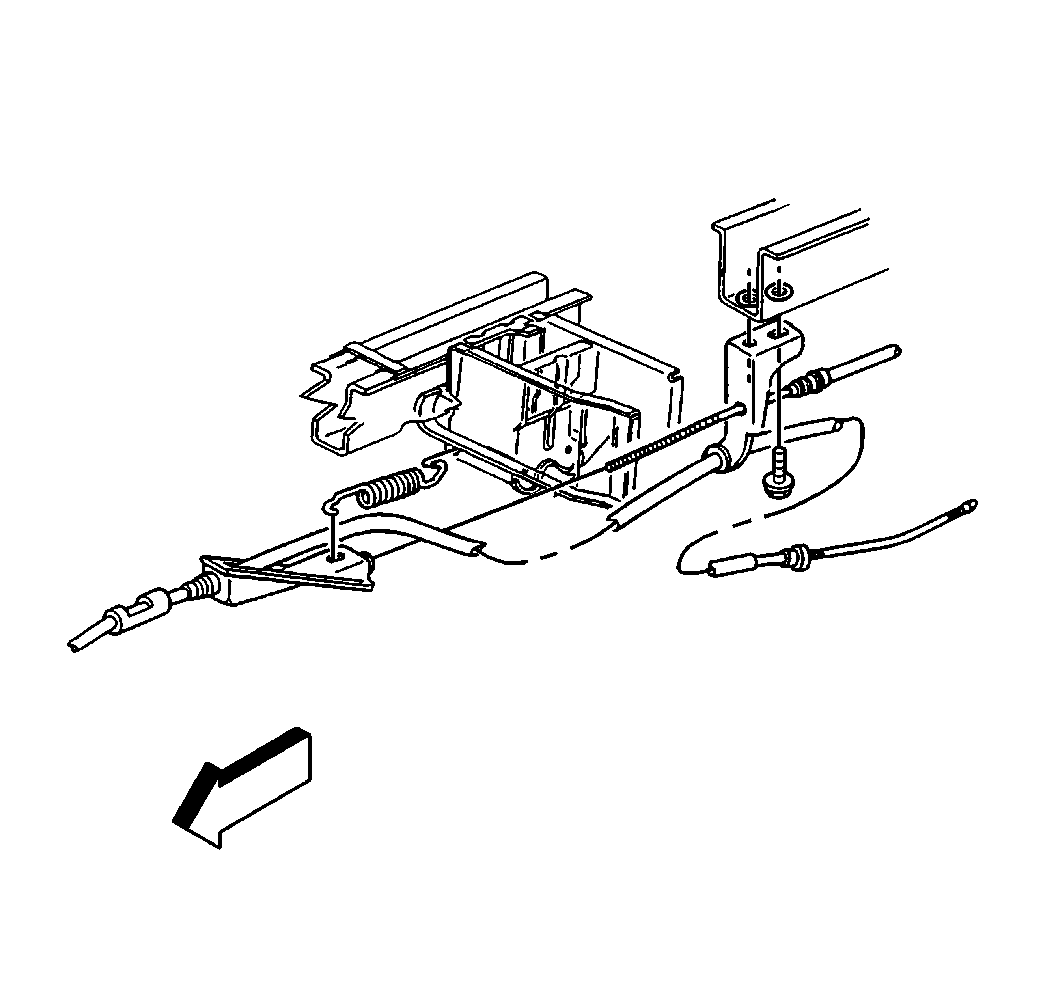
- Remove the park brake bracket from the frame.
- Disconnect the rear brake pipe from the brake pressure modulator valve (BPMV). Refer to
Brake Pressure Modulator Valve Replacement
in Antilock Brake System.
- Remove the front bumper. Refer to
Front Bumper Impact Bar Replacement
in Bumpers.
- Disconnect the power steering cooler from the front air deflector. Refer to
Power Steering Cooler Pipe/Hose Replacement
in Power Steering Systems.
- Disconnect the inflatable restraint front end discriminating sensor electrical connector. Refer to
Inflatable Restraint Front End Discriminating Sensor Replacement
in SIR.
- Disconnect the fender wheelhouse extensions from the chassis to the frame. Refer to
Wheelhouse Extension Replacement
in Body Front End.
- Disconnect the rear air conditioning pipes at the rear crossmember, if equipped.
Leave the air conditioning pipes attached to the powertrain assembly. Refer to
Accumulator Tube Replacement - Auxiliary Side
in Heating Ventilation and Air Conditioning.
- Disconnect the fuel pipes at the fuel filter. Refer to
Fuel Hose/Pipes Assembly Replacement
in Engine Controls-4.3L.
- Pull the fuel pipes through the crossmember (forward). Lay the fuel pipes on the transmission.
- Disconnect the fuel tank electrical connector.
- Disconnect the EVAP vent valve electrical connector.
- Remove the bolt and the ground wire at the chassis by the EVAP vent valve.
- Make sure all the connections are disconnected between the chassis and the frame.
- Remove the engine wiring harness clips from the frame and the cross sills.
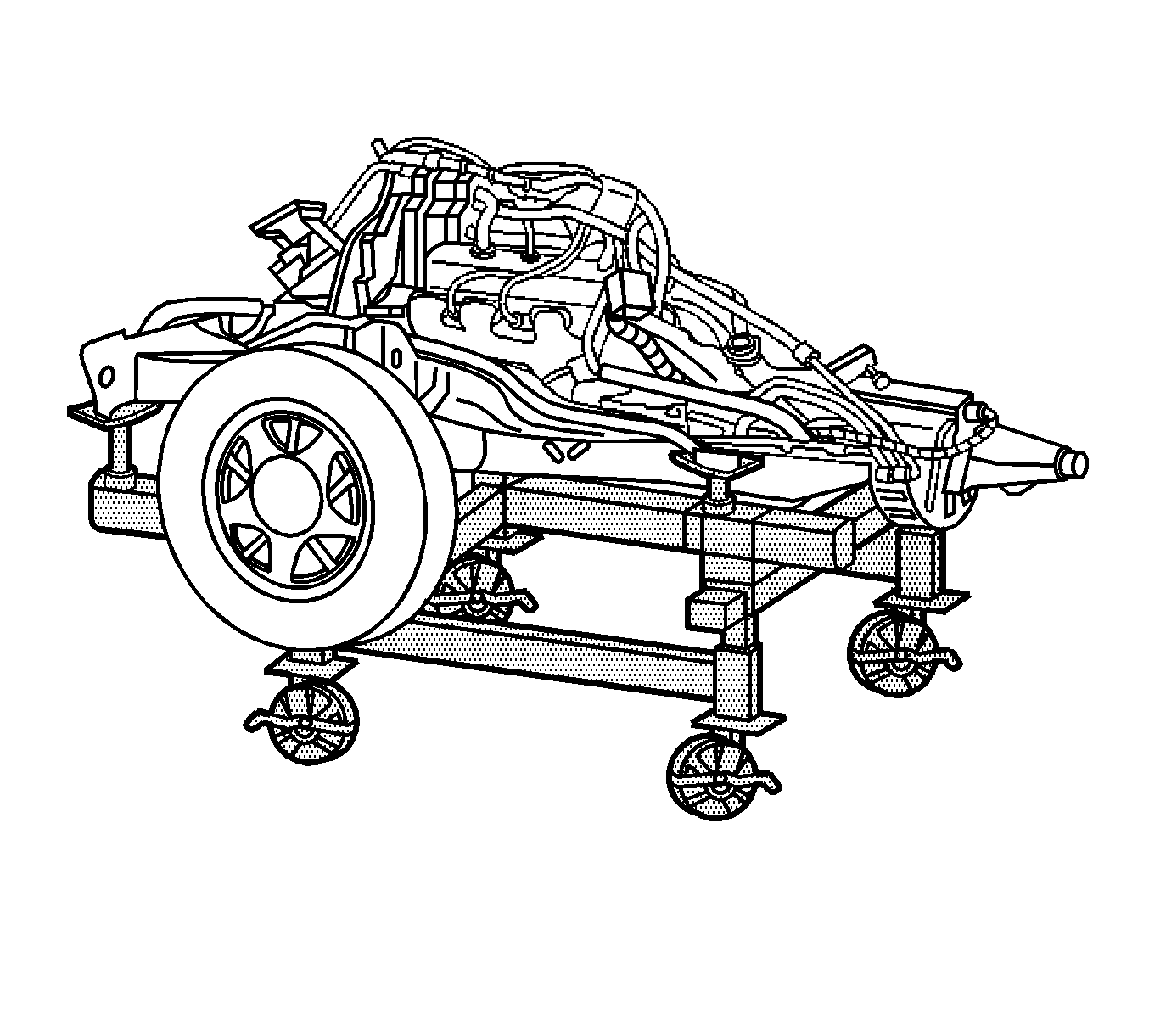
- Position the J 39580
under the engine/frame assembly.
- Lower the vehicle.
- Adjust J 39580
in order to correctly support the frame assembly with the following components:
| • | The front suspension components |
| • | The front differential carrier assembly, if equipped |
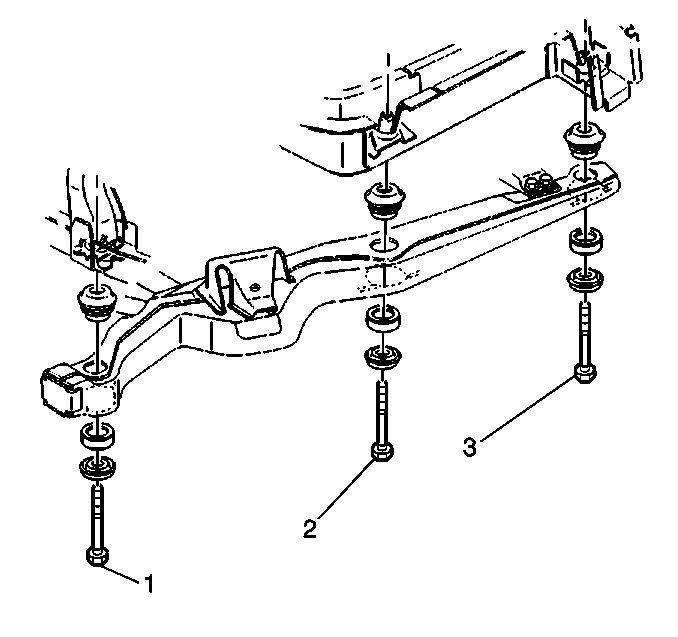
- Remove the body mount bolts (1,2,3). Refer to
Frame Cushion or Insulator Replacement
in Frame and Underbody.
- Place a jack stand under the transmission crossmember to prevent the engine/frame assembly from tipping off of the J 39580
.
- Raise the hoist in order to separate the body from the engine/frame assembly.
- Install support stands under the rear axle.
- Move the engine/frame assembly from under the vehicle.

- Remove the bolt holding the starter wiring harness and the transmission oil cooler pipe bracket to the oil pan.
- Remove the generator. Refer to
Generator Replacement
in Engine Electrical.
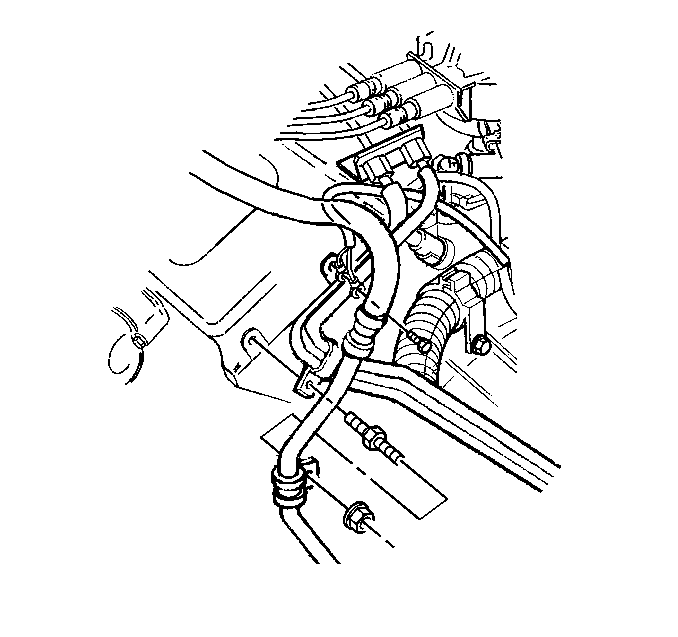
- Remove the nut and the A/C pipe bracket, if equipped from the fuel pipe bracket stud.
- Remove the stud holding the fuel pipe bracket to the rear of the left cylinder head.
- Remove the fuel pipe stud nut on the side of the transmission.
- Move the fuel pipes back to clear the engine.
- Disconnect the fuel pipes at the rear of the engine. Refer to
Fuel Hose/Pipes Replacement - Engine Compartment
in Engine Controls-4.3L.
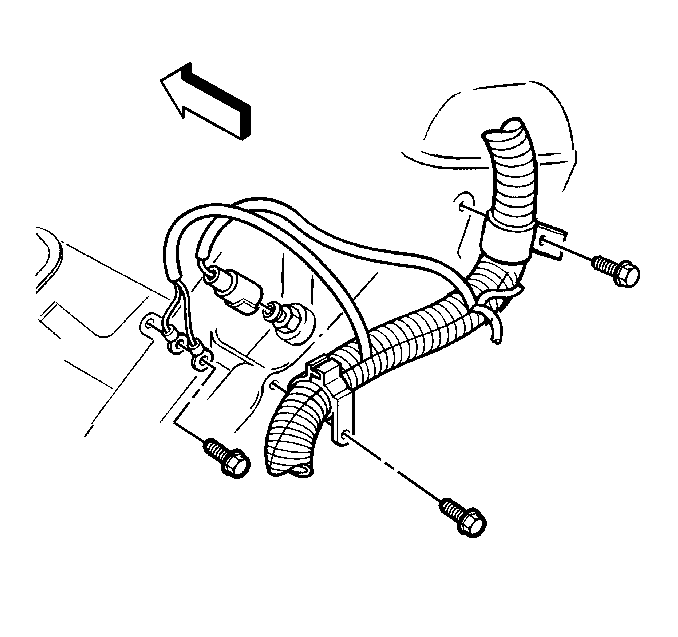
- Remove the ground wire bolt and ground wire from the rear of the left cylinder head.
- Remove the bolt holding the engine wiring harness clip to the rear of the right cylinder head.
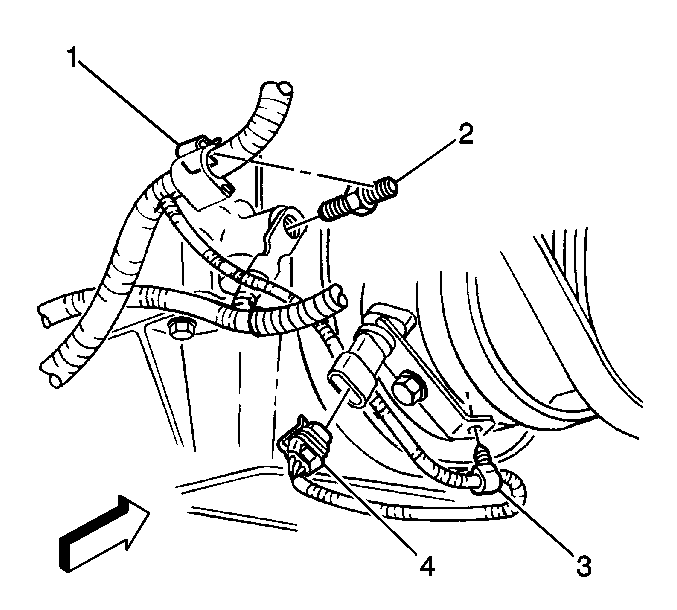
- Disconnect the crankcase position (CKP) sensor electrical connector (4).
- Remove the CKP sensor wiring harness clip (3) from the bracket.
- Remove the engine wiring harness clip (1) from the negative battery cable stud (2).
- Remove the negative battery cable stud (1) and the cable.
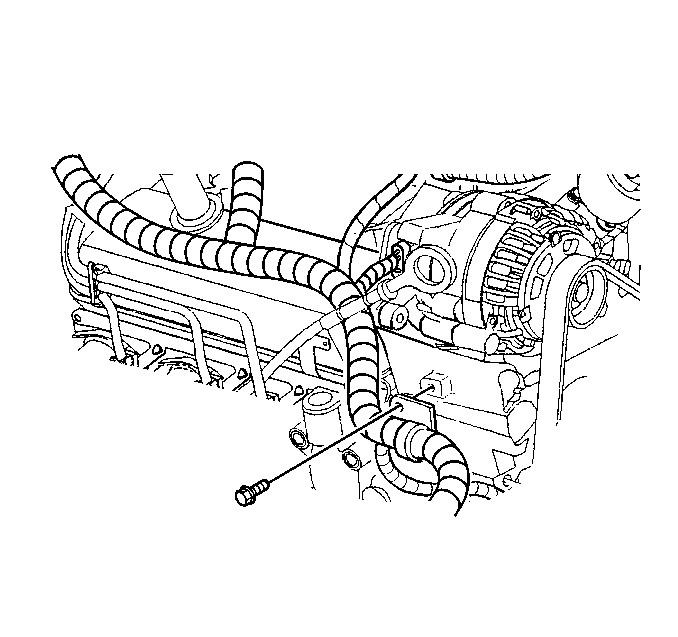
- Remove the bolt holding the engine wiring harness bracket to the generator mounting bracket.
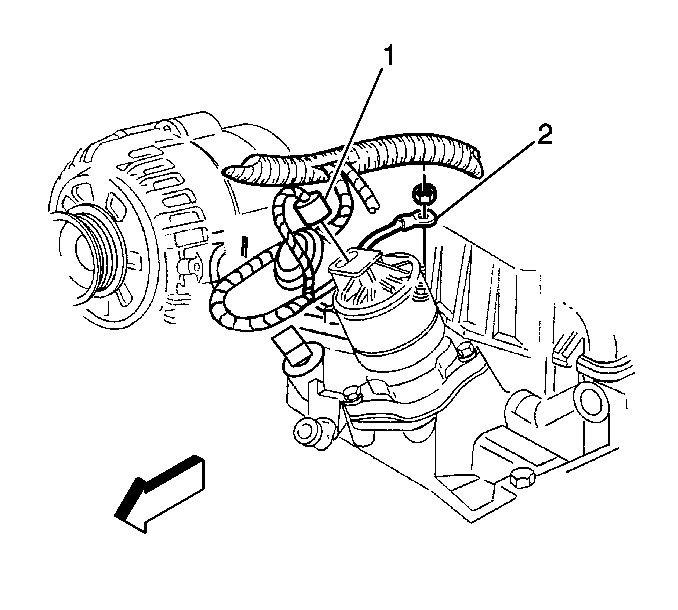
- Disconnect the EGR valve electrical connector (1).
- Remove the ground wire (2) from the stud at the water outlet.
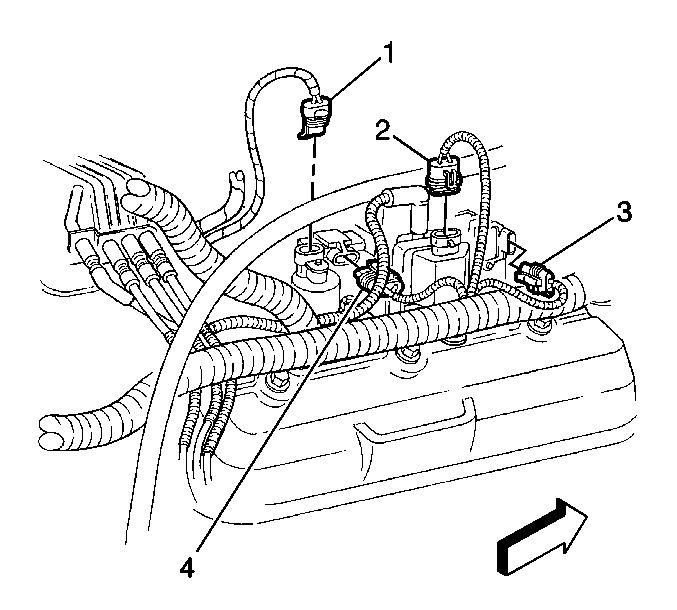
- Disconnect the following electrical connectors:
| • | The manifold absolute pressure (MAP) sensor (4) |
| • | The EVAP canister purge solenoid valve (1) |
| • | The ignition coil module (ICM) (3) |
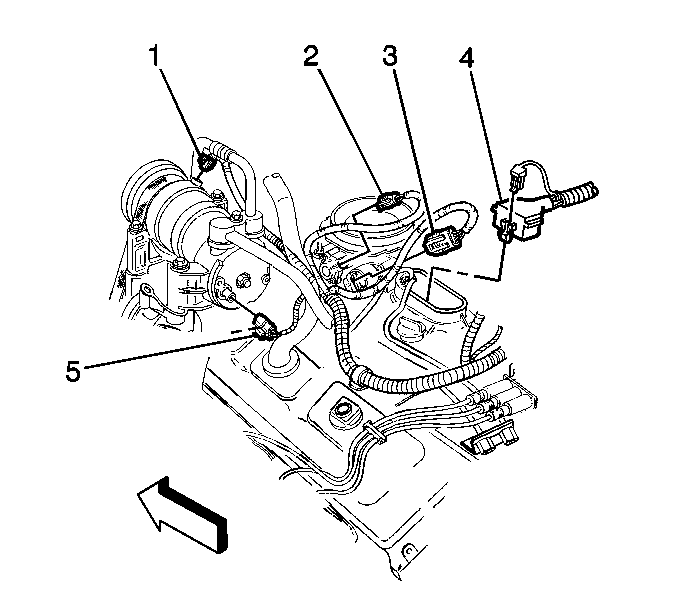
- Disconnect the following electrical connectors:
| • | The A/C compressor clutch, if equipped (1) |
| • | The A/C high pressure cutoff switch, if equipped (5) |
| • | The throttle position (TP) sensor (2) |
| • | The idle air control (IAC) motor (3) |
| • | The fuel meter body assembly connector (4) |
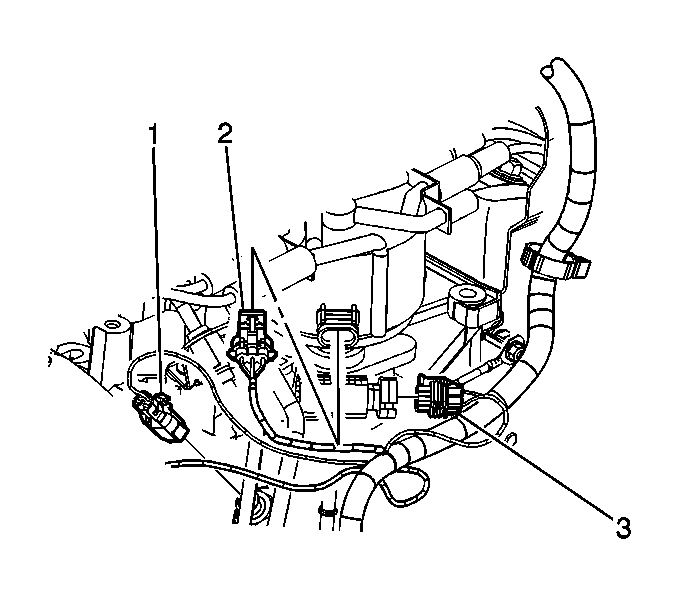
- Disconnect the following electrical connectors:
| • | The knock sensor (KS) (1) |
| • | The engine oil pressure sensor (3) |
- Remove the engine wiring harness from the brackets.
- Remove the bolts holding the transmission fluid fill tube from the oil indicator and the bell housing bolt.
- Move the transmission fluid tube to the side.
- Position the engine wiring harness out of the way.
- Remove the transfer case to engine block brace, if equipped.
- Remove the exhaust pipe from the exhaust manifolds. Refer to
Catalytic Converter Replacement
in Engine Exhaust.
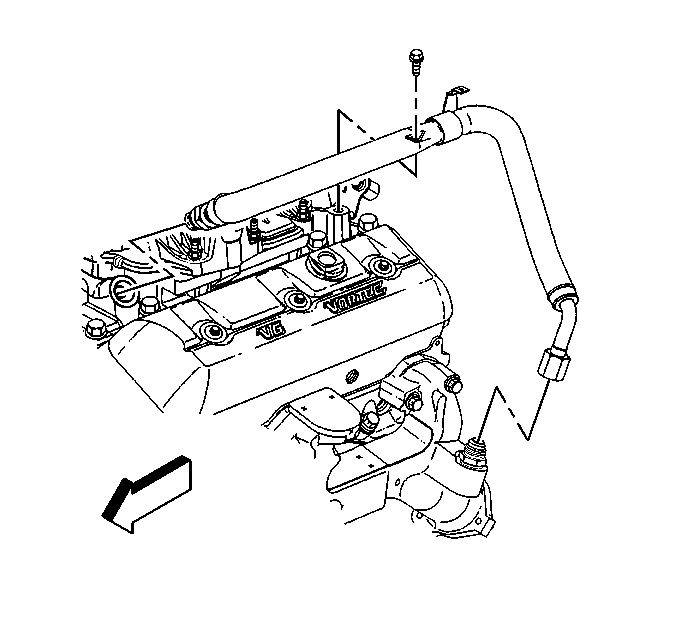
- Remove the spark plug wire harness retainer from the exhaust gas recirculation (EGR) valve inlet pipe.
- Remove the clamp bolt for the EGR valve inlet pipe.
- Remove the EGR valve inlet pipe from the intake and the exhaust manifolds.
- Disconnect the spark plug wires from the spark plugs. Refer to
Spark Plug Wire Replacement
in Engine Controls-4.3L.
- Remove the distributor cap with the spark plug wire harness. Refer to
Distributor Replacement
in Engine Controls-4.3L.
- Remove the air conditioning pipe bracket nut from the intake manifold stud.
- Remove the air conditioning compressor and the power steering pump, leaving the pump and the compressor on the bracket.
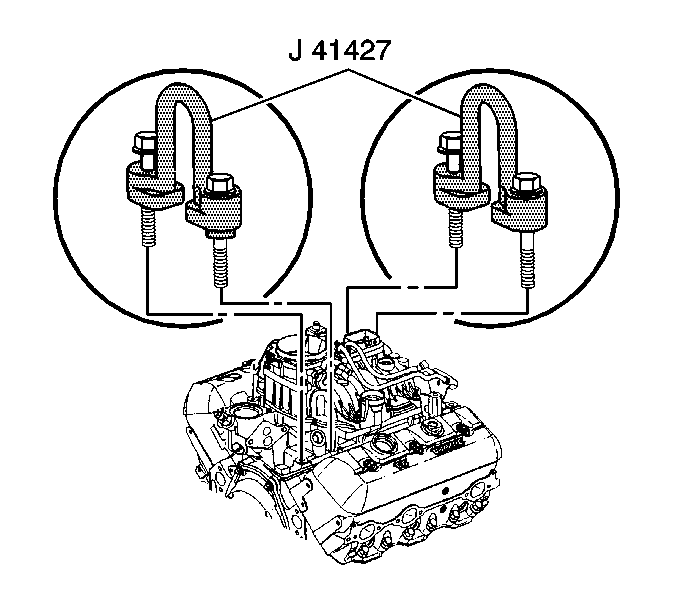
- Install the J 41427
using the following procedure:
| 94.1. | Remove the 2 right rear lower intake manifold bolts. |
| 94.2. | Install the J 41427
marked RIGHT REAR. |
Notice: Use the correct fastener in the correct location. Replacement fasteners
must be the correct part number for that application. Fasteners requiring
replacement or fasteners requiring the use of thread locking compound or sealant
are identified in the service procedure. Do not use paints, lubricants, or
corrosion inhibitors on fasteners or fastener joint surfaces unless specified.
These coatings affect fastener torque and joint clamping force and may damage
the fastener. Use the correct tightening sequence and specifications when
installing fasteners in order to avoid damage to parts and systems.
| 94.3. | Install the retaining bolts. |
Tighten
Tighten the retaining bolts to 15 N·m (11 lb ft).
| 94.4. | Remove the 2 left front lower intake manifold bolts. |
| 94.5. | Install the J 41427
marked LEFT FRONT with the arrow pointing to the front of the engine. |
| 94.6. | Install the retaining bolts |
Tighten
Tighten the retaining bolts to 15 N·m (11 lb ft).
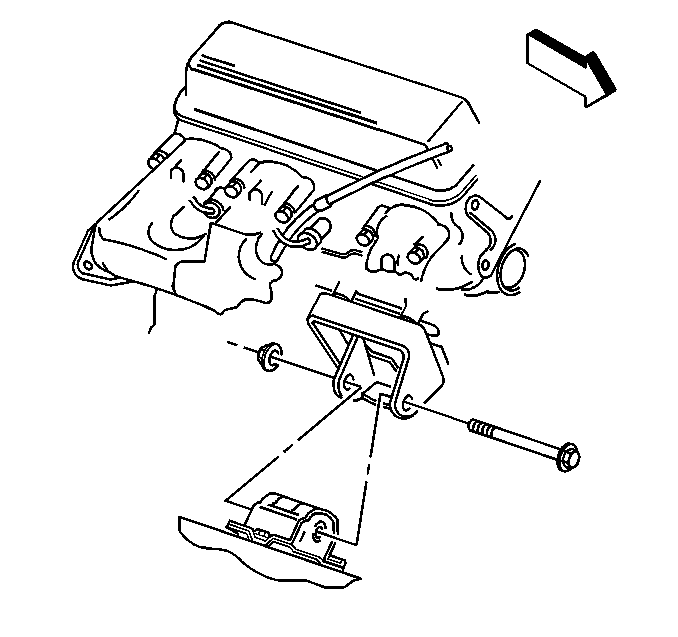
- Remove the engine mount through bolts.
- Raise the engine slightly. Support the front of the transmission with suitable floor stand and a block of wood. Do not support the transmission under the oil pan.
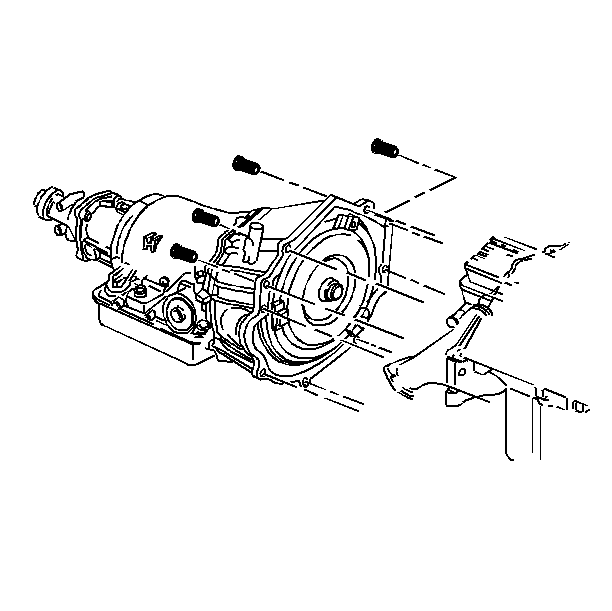
- Remove the transmission to engine bolts.
- Disconnect the engine from the transmission.
- Remove the engine from the frame.
Important: If you install a new engine, make sure any remaining components, brackets, or accessories are transferred to the new engine.
- Install the engine into the frame.
- Connect the engine to the transmission. Refer to
Transmission Replacement
in Automatic Transmission-4L60-E.
- Remove the support from under the transmission.
- Lower the engine and the transmission onto the engine mounts.

Notice: Use the correct fastener in the correct location. Replacement fasteners
must be the correct part number for that application. Fasteners requiring
replacement or fasteners requiring the use of thread locking compound or sealant
are identified in the service procedure. Do not use paints, lubricants, or
corrosion inhibitors on fasteners or fastener joint surfaces unless specified.
These coatings affect fastener torque and joint clamping force and may damage
the fastener. Use the correct tightening sequence and specifications when
installing fasteners in order to avoid damage to parts and systems.
- Install the engine mount through-bolts and nuts.
Tighten
Tighten the engine mount through-bolt nuts to 68 N·m (50 lb ft).

- Remove the J 41427
from the engine.
- Apply thread lock GM P/N 12345382 or equivalent to the threads of the lower intake manifold bolts.
- Install the intake manifold bolts.
Tighten
- Tighten each of the bolts to 3 N·m (27 lb in).
- Tighten each of the bolts to 12 N·m (106 lb in).
- Tighten each of the bolts to 15 N·m (11 lb ft).

- Install the EGR valve inlet pipe to the intake manifold and the exhaust manifold.
Tighten
- Tighten the EGR valve inlet pipe intake manifold nut to 25 N·m (18 lb ft).
- Tighten the EGR valve inlet pipe exhaust manifold nut to 30 N·m (22 lb ft).
- Tighten the EGR valve inlet pipe clamp bolt 25 N·m (18 lb ft).
- Install the air conditioning compressor, if equipped, and the power steering pump mounting bracket.
- Install the distributor cap.
- Install the spark plug wires.
- Install the spark plug wire harness retainer on the EGR valve inlet pipe.
- Install the exhaust pipe to the exhaust manifolds. Refer to
Catalytic Converter Replacement
in Engine Exhaust.
- Connect the fuel pipes at the rear of the engine. Refer to
Fuel Hose/Pipes Replacement - Engine Compartment
in Engine Controls-4.3L.
- Install the transfer case to engine block brace, if equipped.

- Install the fuel pipe bracket and stud to the rear of the left cylinder head.
Tighten
Tighten the fuel pipe bracket stud to 33 N·m (24 lb ft).
- Install the A/C pipe bracket and nut , if equipped, to the fuel pipe bracket stud.
Tighten
Tighten the A/C pipe bracket nut to 35 N·m (26 lb ft).

- Position the engine wiring harness.
- Install the engine wiring harness clips in the brackets.
- Install the engine wiring harness clip bolt to the rear of the right cylinder head.
Tighten
Tighten the engine wiring harness clip bolt to 36 N·m (27 lb ft).
- Install the ground wire and bolt at the rear of the left cylinder head.
Tighten
Tighten the ground wire bolt to 35 N·m (26 lb ft).

- Install the engine wiring harness bracket and bolt to the generator mounting bracket.
Tighten
Tighten the engine wiring harness bolt to 35 N·m (26 lb ft).

- Install the negative battery cable and stud (2).
Tighten
Tighten the negative battery cable stud to 40 N·m (30 lb ft).
- Install the CKP sensor wiring harness clip (3) in the bracket.
- Connect the CKP sensor electrical connector (4).
- Install the engine wiring harness clip (1) on the negative battery cable stud (2).

- Connect the following electrical connectors:
| • | The knock sensor (KS) (1) |
| • | The engine oil pressure sensor (3) |

- Connect the following electrical connectors:
| • | The manifold absolute pressure (MAP) sensor (4) |
| • | The EVAP canister purge solenoid valve (1) |

- Connect the following electrical connectors:
| • | The A/C compressor clutch (1), if equipped |
| • | The A/C high pressure cutoff switch (5), if equipped |
| • | The throttle position (TP) sensor (2) |
| • | The idle air control (IAC) motor (3) |
| • | The fuel meter body assembly connector (4) |

- Connect the EGR valve electrical connector (1).
- Install the ground wire (2) and the nut to the water outlet stud.
Tighten
Tighten the ground wire nut to 19 N·m (14 lb ft).
- Install the generator. Refer to
Generator Replacement
in Engine Electrical.

- Install the bolt for the starter wiring harness and the transmission oil cooler pipe bracket.
Tighten
Tighten the starter wiring harness bracket bolt to 10 N·m (89 lb in).

Important: Align the frame using the 2 alignment holes in the frame and the body. Use a pry bar or dowel pin in order to align the holes as the vehicle is being lowered onto the engine/frame assembly.
- Lower the vehicle onto the engine/frame assembly and the J 39580
.

Important: The 6 frame-to-body bolts must be tightened in sequence in order to ensure correct alignment of the frame to the chassis.
- Install the bolts (1, 2, 3).
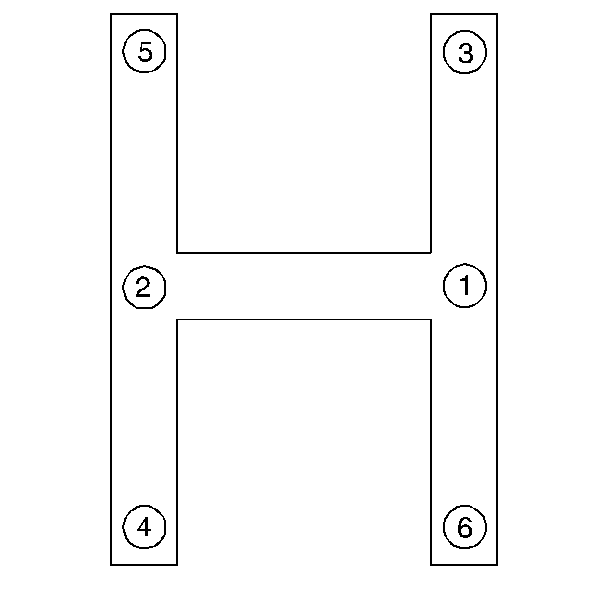
- Tighten the body bolts using the following sequence:
Tighten
- Tighten all of the body bolts in the sequence shown to 35 N·m (26 lb ft).
- Tighten the right center body bolt to 155 N·m (114 lb ft).
- Tighten the left center body bolt to 155 N·m (114 lb ft).
- Tighten the right front body bolt to 90 N·m (66 lb ft).
- Tighten the left rear body bolt to 90 N·m (66 lb ft).
- Tighten the left front body bolt to 90 N·m (66 lb ft).
- Tighten the right rear body bolt to 90 N·m (66 lb ft).
- Raise the vehicle.

- Install the transfer case vent tube, if equipped.
- Connect the wire connector to the wiring harness above the transmission.
- Connect the shift cable to the transmission. Refer to
Range Selector Lever Cable Replacement
in Automatic Transmission - 4L60-E.
- Install the torque converter bolts.
Tighten
Tighten the bolts to 62 N·m (46 lb ft).
- Install the transmission cover.
Tighten
Tighten the transmission cover bolts to 12 N·m (106 lb in).
- Install the starter. Refer to
Starter Motor Replacement
in Engine Electrical.
- Install the oil cooler pipes to the oil filter adapter. Refer to
Engine Oil Cooler Hose/Pipe Replacement
in Engine Cooling.
- Install the rear propeller shaft. Refer to
Rear Propeller Shaft Replacement
in Propeller Shaft.
- Connect the power steering cooler. Refer to
Power Steering Cooler Pipe/Hose Replacement
in Power Steering Systems.
- Connect the inflatable restraint front end discriminating sensor electrical connector. Refer to
Inflatable Restraint Front End Discriminating Sensor Replacement
in SIR.
- Connect the fender wheelhouse extensions from chassis to the frame. Refer to
Wheelhouse Extension Replacement
in Body Front End.
- Install the front bumper. Refer to
Front Bumper Impact Bar Replacement
in Bumpers.
- Install the muffler and the tail pipe section to the hangers and install it to the converter assembly. Refer to
Catalytic Converter Replacement
in Engine Exhaust.
- Connect the fuel pipes at the fuel filter. Refer to
Fuel Hose/Pipes Assembly Replacement
in Engine Controls-4.3L.
- Position the engine wiring harness in the clips on the frame and the cross sills.
- Connect the fuel tank electrical connector.
- Connect the EVAP vent valve electrical connector.
- Install the bolt and the ground wire at the chassis by the EVAP vent valve.
Tighten
Tighten the ground wire bolt to 9 N·m (80 lb in).
- Ensure that all of the electrical connections are connected between the chassis and the frame.

- Install the bolt and the park brake bracket to the frame.
Tighten
Tighten the park brake bracket bolt to 24 N·m (17 lb ft).
- Connect the rear air conditioning pipes at the rear crossmember by the fuel tank fill hoses, if equipped.
- Connect the rear brake pipe to the BPMV. Refer to
Brake Pressure Modulator Valve Replacement
in Antilock Brake System.
- Remove the bell housing to transmission bolt.
- Lower the vehicle.

- Remove both of the J 41602
.
- Install the front section of the running boards. Refer to
Assist Step Front Extension Replacement
in Frame and Underbody.
- Install the battery cable assembly to the fender and the radiator support. Refer to
Battery Negative Cable Replacement
in Engine Electrical.
- Install the battery positive cable but do not install the battery negative cable.
- Install the wiring harness in the retainers clips along the bulkhead.
- Connect the fuse box and the wiring harness to the bulkhead connector.
- Connect all related connectors including the following:
| • | The cruise control module |
| • | The differential pressure input switch |
- Connect the steering shaft to the steering gear. Refer to
Intermediate Steering Shaft Replacement
in Steering Wheel and Column.
- Connect the heater hoses to the engine. Refer to
Heater Inlet Hose Replacement
in Heating Ventilation and Air Conditioning.

- Connect the vacuum hose for the vacuum tank to the intake manifold.
- Connect the pipes to the hydro boost. Refer to
Power Brake Booster Replacement
in Hydraulic Brakes.
- Install the power steering reservoir. Refer to
Remote Power Steering Fluid Reservoir Replacement
in Power Steering System.
- Install the master cylinder to the hydro boost. Refer to
Master Cylinder Replacement
in Hydraulic Brakes.
Caution: In order to avoid possible injury or vehicle damage, always replace
the accelerator control cable with a NEW cable whenever you remove the engine
from the vehicle.
In order to avoid cruise control cable damage, position the cable out
of the way while you remove or install the engine. Do not pry
or lean against the cruise control cable and do not kink the cable. You must
replace a damaged cable.
- Install the NEW accelerator control cable. Refer to
Accelerator Control Cable Replacement
in Engine Controls-4.3L.
- Connect the cruise control cable to the throttle shaft and the accelerator control cable bracket. Refer to
Cruise Control Cable Replacement
in Cruise Controls.
- Connect the air conditioning pipes at the accumulator and the condenser, if equipped. Refer to
Auxiliary Air Conditioning Compressor and Condenser Hose Replacement
in Heating Ventilation and Air Conditioning.
- Install the radiator. Refer to
Radiator Replacement
in Engine Cooling.
- Fill the cooling system with the correct grade of engine coolant. Refer to
Cooling System Draining and Filling
in Engine Cooling.
- Install the air cleaner outlet duct to the throttle body. Refer to
Air Cleaner Outlet Resonator Replacement
in Engine Controls-4.3L.
- Install the air cleaner assembly. Refer to
Air Cleaner Assembly Replacement
in Engine Controls-4.3L.
- Fill the crankcase with the correct grade of engine oil. Refer to
Engine Oil and Oil Filter Replacement
.
- Fill and bleed the brake system. Refer to
Hydraulic Brake System Bleeding
in Hydraulic Brakes.
- Fill the transmission with the correct grade and quantity of transmission fluid. Refer to
Automatic Transmission Fluid and Filter Replacement
in Automatic Transmission-4L60-E.
- Fill the power steering system with the correct grade and quantity of power steering fluid. Refer to
Checking and Adding Power Steering Fluid
in Power Steering System.
- Connect the battery negative cable. Refer to
Battery Negative Cable Disconnection and Connection
in Engine Electrical.
- Recharge the air conditioning system and check for correct operation, if equipped. Refer to
Refrigerant Recovery and Recharging
in Heating, Ventilation and Air Conditioning.
- Install the engine cover. Refer to
Engine Cover Replacement
in Interior Trim.
- Perform a crankshaft variation learn procedure. Refer to
Crankshaft Position System Variation Learn
in Engine Controls.
- Operate the engine and check for correct operation.








































